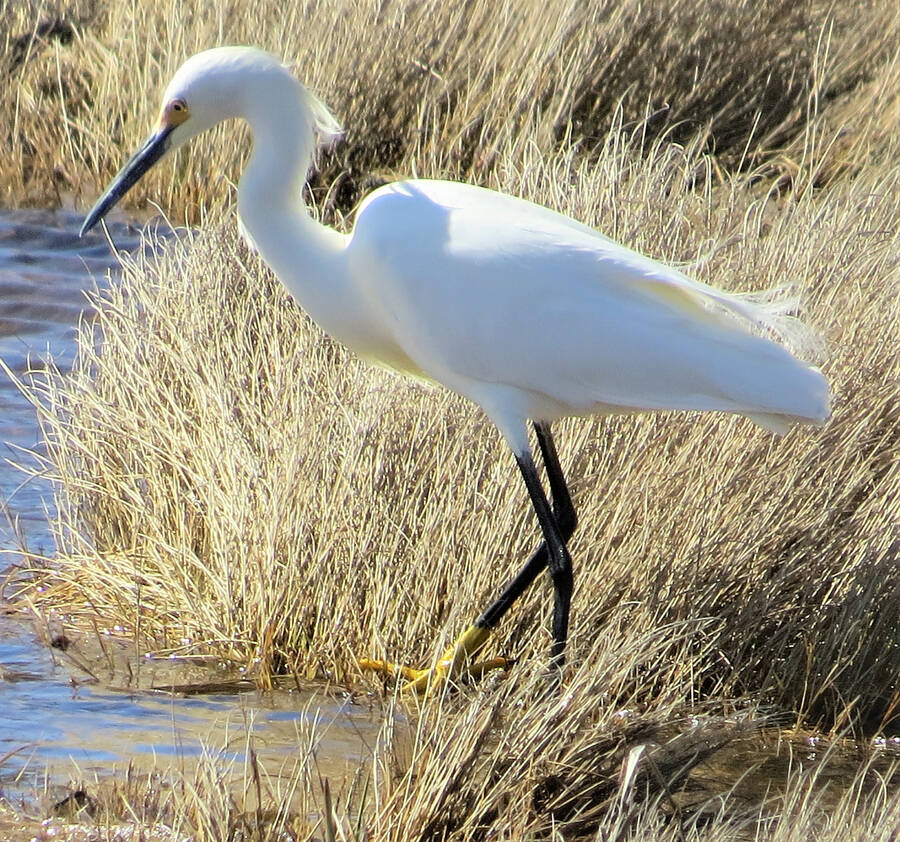
2023-05-17
Taking a closer look at the snowy egret
Lise Bell located a snowy egret at Crescent Beach on May 2. Thanks to her discovery, a number of people were able to go and see this bird.
The snowy egret is native in North, Central and South America. They nest in California, Idaho, Colorado, Oklahoma, the Gulf coast and Maine, in Arizona, New Mexico, Florida, Mexico to South America and the West Indies. There is at least one breeding record for Nova Scotia. They winter in California, Arizona, Texas, the Gulf coast, Florida and South Carolina.
The snowy egret is 55 to 65 cm long with a wingspread of 95 to 112.5 cm. They are all white with a black bill, black legs, and bright yellow feet. In breeding season these egrets have plumes. The food of the snowy egret is fish, frogs, lizards, snakes, shrimp, fiddler crabs, crayfish, grasshoppers, cutworms, and aquatic insects.
On May 2, the windy, stormy weather that we had was not good for the birds and many died. On that date I was saddened to see a dead pileated woodepecker in the middle of the road in Pentz. Gillian Trueman had found a dead male indigo bunting on her woods cart road in Kingsburg. Dorthy Poole reported that the death of a ruby-crowned kinglet had happened in Milton.
On a brighter note, at her cottage in Port Joli, Joyce Allen saw an indigo bunting on April 23. Another one or the same bird showed up on May 3. Joyce also had one red crossbill.
On May 4, Neala Colp of Hebbville saw a male indigo bunting. Marg Millard of White Point had a male ruby-throated hummingbird show up on May 4 and Cathy Ramey of Crousetown had one on May 7. I also saw reports of this bird being seen elsewhere in Lunenburg County and across the province. On May 4, Ken MacAulay of Port Mouton still had a red-bellied woodpecker. Also a yellow-rumped warbler was feeding at his suet.
David and Pat Watson reported a turkey vulture that they saw as they were driving along Route 3 and heading towards Lunenburg on May 6. Also on that day, Marjorie Zwicker of Auburndale was able to pick up a red-breasted nuthatch and a yellow-rumped warbler call on the Merlin Bird Finder App.
On May 7, Mary Kennedy sighted a black-bellied plover at Crescent Beach. Lise Bell of Bush Island had a chipping sparrow arrive on that day. Barbara McLean was lucky to see white-winged crossbills by the Independent Store in Lunenburg. I was thrilled to see a veery feeding on the lawn of my yard in LaHave on May 7. It was species 109 for my yard list.
On May 8, Kerry Jarvis reported that tree swallows were bringing nesting materials into his nest boxes. Kerry also saw six willets and four greater yellowlegs at the Oxner's Beach saltmarsh. Donnie Hume of Garden Lots saw his first female red-winged blackbird for the year. The males have been back for awhile now. On May 9 an orchard oriole showed up at the hummingbird feeder of Paul Harmon in Petite Riviere.
On May 5, Ervin Olsen had a red-eyed vireo and a northern parula at Cranberry Head. On that same day Mark Dennis reported a cattle egret at Cheboggin. On May 6, Eric Mills located a snowy egret on Brier Island. Ervin Olsen discovered a white-crowned sparrow at Chebogue and a black-throated green warbler at Cranberry Head.
May 7 produced arctic, common and roseate terns at the Brothers Islands for Alix d'Entremont and others. Ervin Olsen found an American redstart and black and white warblers at Cape Forchu. On May 8, a purple martin and a blue-winged teal was seen at Pont du Marais by Alix d'Entremont. On Stony Island at Cape Sable Island on the same day, Tony Millard discovered an alder flycatcher.
Returning migrant species seen in the valley from May 1 to 8 were rusty blackbird, black and white warbler, Virginia rail, common yellowthroat, chimney swifts, Swainson's thrush, pied-billed grebe and yellow warbler.
You may reach me at (902) 693-2174 or email jrhbirder@hotmail.com






